
Illustrative Math Alignment: Grade 7 Unit 8
Probability and Sampling
Lesson 11: Comparing Groups
Use the following Media4Math resources with this Illustrative Math lesson.
| Thumbnail Image | Title | Body | Curriculum Topic |
|---|---|---|---|
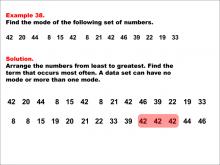
|
Math Example--Measures of Central Tendency--Mode: Example 38 | Math Example--Measures of Central Tendency--Mode: Example 38TopicMeasures of Central Tendency DescriptionThis example showcases a situation of measures of central tendency, where the goal is to identify a key summary measure in a set of data. An example showing how to find the mode in a set of numbers is presented. The numbers are sorted and analyzed to find that "42" is the mode. This demonstrates how to identify the mode when a number appears more frequently than others in a data set. |
Data Analysis |
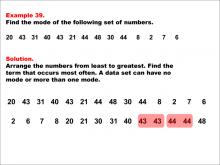
|
Math Example--Measures of Central Tendency--Mode: Example 39 | Math Example--Measures of Central Tendency--Mode: Example 39TopicMeasures of Central Tendency DescriptionThis example showcases a situation of measures of central tendency, where the goal is to identify a key summary measure in a set of data. An example illustrating how to find the mode in a set of numbers is presented. The numbers are sorted and analyzed to reveal two modes: "43" and "44." This demonstrates that a data set can have multiple modes, which occurs when two or more numbers appear with the highest frequency. |
Data Analysis |
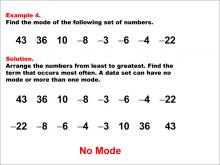
|
Math Example--Measures of Central Tendency--Mode: Example 4 | Math Example--Measures of Central Tendency--Mode: Example 4TopicMeasures of Central Tendency DescriptionThis example showcases a situation of measures of central tendency, where the goal is to identify a key summary measure in a set of data. The image displays a set of numbers with an example for finding the mode. After arranging them, it concludes that there is no mode. This example reinforces the concept that not all data sets have a mode, particularly when each number appears only once in the set. |
Data Analysis |
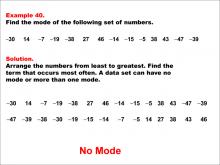
|
Math Example--Measures of Central Tendency--Mode: Example 40 | Math Example--Measures of Central Tendency--Mode: Example 40TopicMeasures of Central Tendency DescriptionThis example showcases a situation of measures of central tendency, where the goal is to identify a key summary measure in a set of data. An example showing how to find the mode in a set of negative and positive numbers is presented. The analysis shows there is "No Mode." This example reinforces the concept that not all data sets have a mode, particularly when each number in the set appears only once. |
Data Analysis |
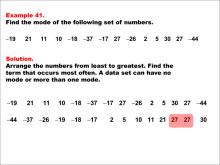
|
Math Example--Measures of Central Tendency--Mode: Example 41 | Math Example--Measures of Central Tendency--Mode: Example 41TopicMeasures of Central Tendency DescriptionThis example showcases a situation of measures of central tendency, where the goal is to identify a key summary measure in a set of data. Example 41 shows a set of numbers with instructions to find the mode. The numbers are arranged from least to greatest, and the number 27 is highlighted as the mode. This demonstrates how to identify the mode when a number appears more frequently than others in a data set that includes both positive and negative numbers. |
Data Analysis |
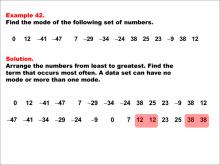
|
Math Example--Measures of Central Tendency--Mode: Example 42 | Math Example--Measures of Central Tendency--Mode: Example 42TopicMeasures of Central Tendency DescriptionThis example showcases a situation of measures of central tendency, where the goal is to identify a key summary measure in a set of data. Example 42 presents a set of numbers with instructions to find the mode. The numbers are sorted from least to greatest, and both 12 and 38 are highlighted as modes. This demonstrates that a data set can have multiple modes, even when it contains both positive and negative numbers. |
Data Analysis |
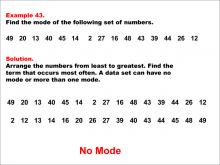
|
Math Example--Measures of Central Tendency--Mode: Example 43 | Math Example--Measures of Central Tendency--Mode: Example 43TopicMeasures of Central Tendency DescriptionThis example showcases a situation of measures of central tendency, where the goal is to identify a key summary measure in a set of data. Example 43 displays a set of numbers with instructions to find the mode. After arranging them from least to greatest, it concludes there is no mode as no number repeats more than once. This example reinforces the concept that not all data sets have a mode, particularly when each number in the set appears only once. |
Data Analysis |
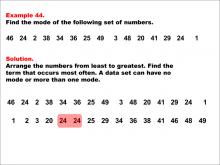
|
Math Example--Measures of Central Tendency--Mode: Example 44 | Math Example--Measures of Central Tendency--Mode: Example 44TopicMeasures of Central Tendency DescriptionThis example showcases a situation of measures of central tendency, where the goal is to identify a key summary measure in a set of data. Example 44 provides a set of numbers with instructions to find the mode. The numbers are arranged in ascending order and the number 24 is highlighted as the mode. This demonstrates how to identify the mode when a number appears more frequently than others in a data set. |
Data Analysis |
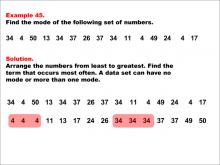
|
Math Example--Measures of Central Tendency--Mode: Example 45 | Math Example--Measures of Central Tendency--Mode: Example 45TopicMeasures of Central Tendency DescriptionThis example showcases a situation of measures of central tendency, where the goal is to identify a key summary measure in a set of data. This image shows Example 45, which involves finding the mode of a set of numbers. The numbers are listed, and the solution involves sorting them and identifying the mode. This example demonstrates that a data set can have multiple modes, which occurs when two or more numbers appear with the highest frequency. |
Data Analysis |
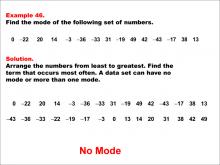
|
Math Example--Measures of Central Tendency--Mode: Example 46 | Math Example--Measures of Central Tendency--Mode: Example 46TopicMeasures of Central Tendency DescriptionThis example showcases a situation of measures of central tendency, where the goal is to identify a key summary measure in a set of data. This image shows Example 46 with a set of numbers to find the mode. The numbers are sorted but no number repeats more than once. This example reinforces the concept that not all data sets have a mode, particularly when each number in the set appears only once. |
Data Analysis |
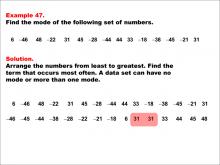
|
Math Example--Measures of Central Tendency--Mode: Example 47 | Math Example--Measures of Central Tendency--Mode: Example 47TopicMeasures of Central Tendency DescriptionThis example showcases a situation of measures of central tendency, where the goal is to identify a key summary measure in a set of data. This image shows Example 47 with a set of numbers to find the mode. The numbers are sorted and one number is identified as the mode. This demonstrates how to identify the mode when a number appears more frequently than others in a data set that includes both positive and negative numbers. |
Data Analysis |

|
Math Example--Measures of Central Tendency--Mode: Example 48 | Math Example--Measures of Central Tendency--Mode: Example 48TopicMeasures of Central Tendency DescriptionThis example showcases a situation of measures of central tendency, where the goal is to identify a key summary measure in a set of data. This image shows Example 48 with a set of numbers to find the mode. The numbers are sorted and two numbers are identified as modes. This demonstrates that a data set can have multiple modes, even when it contains both positive and negative numbers. |
Data Analysis |

|
Math Example--Measures of Central Tendency--Mode: Example 49 | Math Example--Measures of Central Tendency--Mode: Example 49TopicMeasures of Central Tendency DescriptionThis example showcases a situation of measures of central tendency, where the goal is to identify a key summary measure in a set of data. This image shows a math example about finding the mode of a set of numbers. The numbers are arranged from least to greatest, and it is determined that there is no mode. This example reinforces the concept that not all data sets have a mode, particularly when each number in the set appears only once. |
Data Analysis |

|
Math Example--Measures of Central Tendency--Mode: Example 5 | Math Example--Measures of Central Tendency--Mode: Example 5TopicMeasures of Central Tendency DescriptionThis example showcases a situation of measures of central tendency, where the goal is to identify a key summary measure in a set of data. Example 5 shows a set of numbers with negative and positive values, highlighting the mode. The example demonstrates that the mode can be found in a data set containing both positive and negative numbers, with 2 being identified as the mode in this case. |
Data Analysis |

|
Math Example--Measures of Central Tendency--Mode: Example 50 | Math Example--Measures of Central Tendency--Mode: Example 50TopicMeasures of Central Tendency DescriptionThis example showcases a situation of measures of central tendency, where the goal is to identify a key summary measure in a set of data. This image shows a math example about finding the mode of a set of numbers. The numbers are arranged from least to greatest with the mode highlighted. This demonstrates how to identify the mode when a number appears more frequently than others in a data set. |
Data Analysis |
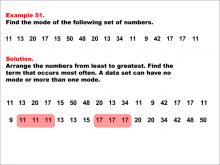
|
Math Example--Measures of Central Tendency--Mode: Example 51 | Math Example--Measures of Central Tendency--Mode: Example 51TopicMeasures of Central Tendency DescriptionThis example showcases a situation of measures of central tendency, where the goal is to identify a key summary measure in a set of data. This image shows a math example about finding the mode of a set of numbers. The numbers are arranged from least to greatest with the modes highlighted. This demonstrates that a data set can have multiple modes, which occurs when two or more numbers appear with the highest frequency. |
Data Analysis |
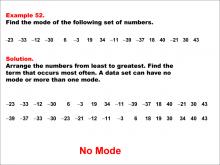
|
Math Example--Measures of Central Tendency--Mode: Example 52 | Math Example--Measures of Central Tendency--Mode: Example 52TopicMeasures of Central Tendency DescriptionThis example showcases a situation of measures of central tendency, where the goal is to identify a key summary measure in a set of data. This image shows a math example about finding the mode of a set of numbers. The numbers are arranged from least to greatest and it is determined that there is no mode. This example reinforces the concept that not all data sets have a mode, particularly when each number in the set appears only once. |
Data Analysis |
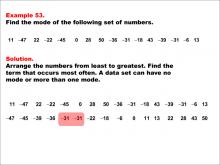
|
Math Example--Measures of Central Tendency--Mode: Example 53 | Math Example--Measures of Central Tendency--Mode: Example 53TopicMeasures of Central Tendency DescriptionThis example showcases a situation of measures of central tendency, where the goal is to identify a key summary measure in a set of data. The image shows a math example focusing on finding the mode of a set of numbers. The numbers are arranged in ascending order to identify the mode. Highlighted numbers indicate the mode. This demonstrates how to identify the mode when a number appears more frequently than others in a data set that includes both positive and negative numbers. |
Data Analysis |
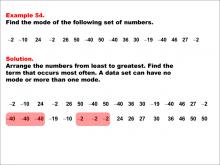
|
Math Example--Measures of Central Tendency--Mode: Example 54 | Math Example--Measures of Central Tendency--Mode: Example 54TopicMeasures of Central Tendency DescriptionThis example showcases a situation of measures of central tendency, where the goal is to identify a key summary measure in a set of data. This image presents a math example about finding the mode. The numbers are sorted in ascending order with highlighted sections showing the modes. This demonstrates that a data set can have multiple modes, even when it contains both positive and negative numbers. |
Data Analysis |
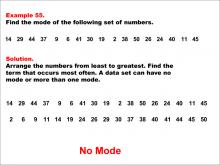
|
Math Example--Measures of Central Tendency--Mode: Example 55 | Math Example--Measures of Central Tendency--Mode: Example 55TopicMeasures of Central Tendency DescriptionThis example showcases a situation of measures of central tendency, where the goal is to identify a key summary measure in a set of data. A math example illustrating how to find the mode of a number set is presented. The numbers are ordered from least to greatest and it concludes that there is no mode. This example reinforces the concept that not all data sets have a mode, particularly when each number in the set appears only once. |
Data Analysis |
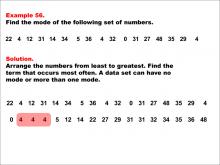
|
Math Example--Measures of Central Tendency--Mode: Example 56 | Math Example--Measures of Central Tendency--Mode: Example 56TopicMeasures of Central Tendency DescriptionThis example showcases a situation of measures of central tendency, where the goal is to identify a key summary measure in a set of data. This image provides an example of finding the mode in a data set. Numbers are arranged in ascending order and highlighted to show which number appears most frequently. This demonstrates how to identify the mode when a number appears more frequently than others in a data set. |
Data Analysis |
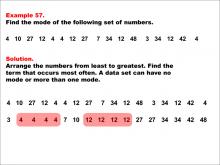
|
Math Example--Measures of Central Tendency--Mode: Example 57 | Math Example--Measures of Central Tendency--Mode: Example 57TopicMeasures of Central Tendency DescriptionThis example showcases a situation of measures of central tendency, where the goal is to identify a key summary measure in a set of data. The image shows a math problem about finding the mode of a set of numbers. It includes the original set of numbers and the same set arranged in ascending order with the mode highlighted. This demonstrates that a data set can have multiple modes, which occurs when two or more numbers appear with the highest frequency. |
Data Analysis |
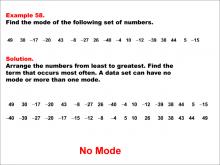
|
Math Example--Measures of Central Tendency--Mode: Example 58 | Math Example--Measures of Central Tendency--Mode: Example 58TopicMeasures of Central Tendency DescriptionThis example showcases a situation of measures of central tendency, where the goal is to identify a key summary measure in a set of data. The image presents a math problem about finding the mode of a set of numbers. It shows the original set and the same set arranged in ascending order. The solution states "No Mode". This example reinforces the concept that not all data sets have a mode, particularly when each number in the set appears only once. |
Data Analysis |
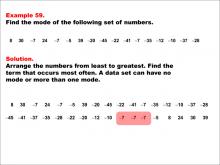
|
Math Example--Measures of Central Tendency--Mode: Example 59 | Math Example--Measures of Central Tendency--Mode: Example 59TopicMeasures of Central Tendency DescriptionThis example showcases a situation of measures of central tendency, where the goal is to identify a key summary measure in a set of data. The image displays a math problem about finding the mode of a set of numbers. It includes the original set of numbers and the same set arranged in ascending order with the mode highlighted. This demonstrates how to identify the mode when a number appears more frequently than others in a data set that includes both positive and negative numbers. |
Data Analysis |
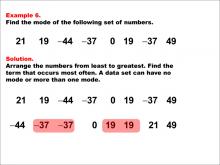
|
Math Example--Measures of Central Tendency--Mode: Example 6 | Math Example--Measures of Central Tendency--Mode: Example 6TopicMeasures of Central Tendency DescriptionThis example showcases a situation of measures of central tendency, where the goal is to identify a key summary measure in a set of data. Example 6 displays a mix of negative and positive numbers with two modes highlighted. The example illustrates that a data set can have multiple modes, even when it contains both positive and negative numbers. In this case, -37 and 19 are identified as the modes. |
Data Analysis |
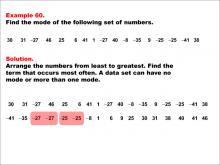
|
Math Example--Measures of Central Tendency--Mode: Example 60 | Math Example--Measures of Central Tendency--Mode: Example 60TopicMeasures of Central Tendency DescriptionThis example showcases a situation of measures of central tendency, where the goal is to identify a key summary measure in a set of data. The image shows a math problem about finding the mode of a set of numbers. It includes the original set of numbers and the same set arranged in ascending order with two potential modes highlighted. This demonstrates that a data set can have multiple modes, even when it contains both positive and negative numbers. |
Data Analysis |

|
Math Example--Measures of Central Tendency--Mode: Example 61 | Math Example--Measures of Central Tendency--Mode: Example 61TopicMeasures of Central Tendency DescriptionThis example showcases a situation of measures of central tendency, where the goal is to identify a key summary measure in a set of data. The image shows Example 61, which involves finding the mode of a set of numbers. The numbers are listed, and then arranged from least to greatest. It concludes with "No Mode." This example reinforces the concept that not all data sets have a mode, particularly when each number in the set appears only once. |
Data Analysis |
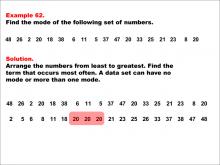
|
Math Example--Measures of Central Tendency--Mode: Example 62 | Math Example--Measures of Central Tendency--Mode: Example 62TopicMeasures of Central Tendency DescriptionThis example showcases a situation of measures of central tendency, where the goal is to identify a key summary measure in a set of data. The image shows Example 62 with a list of numbers. After sorting them in ascending order, it identifies the mode as "20." This demonstrates how to identify the mode when a number appears more frequently than others in a data set. |
Data Analysis |

|
Math Example--Measures of Central Tendency--Mode: Example 63 | Math Example--Measures of Central Tendency--Mode: Example 63TopicMeasures of Central Tendency DescriptionThis example showcases a situation of measures of central tendency, where the goal is to identify a key summary measure in a set of data. The image shows Example 63 with a list of numbers. After sorting them in ascending order, it identifies two modes: "20" and "44." This demonstrates that a data set can have multiple modes, which occurs when two or more numbers appear with the highest frequency. |
Data Analysis |

|
Math Example--Measures of Central Tendency--Mode: Example 64 | Math Example--Measures of Central Tendency--Mode: Example 64TopicMeasures of Central Tendency DescriptionThis example showcases a situation of measures of central tendency, where the goal is to identify a key summary measure in a set of data. The image shows Example 64 with a list of numbers. After sorting them in ascending order without any repetition in frequency higher than others, it concludes with "No Mode." This example reinforces the concept that not all data sets have a mode, particularly when each number in the set appears only once. |
Data Analysis |
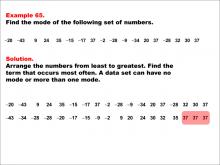
|
Math Example--Measures of Central Tendency--Mode: Example 65 | Math Example--Measures of Central Tendency--Mode: Example 65TopicMeasures of Central Tendency DescriptionThis example showcases a situation of measures of central tendency, where the goal is to identify a key summary measure in a set of data. Example 65 shows a list of numbers with the mode highlighted. The numbers are arranged in ascending order. This demonstrates how to identify the mode when a number appears more frequently than others in a data set that includes both positive and negative numbers. |
Data Analysis |
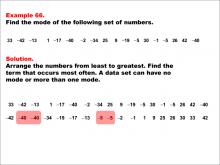
|
Math Example--Measures of Central Tendency--Mode: Example 66 | Math Example--Measures of Central Tendency--Mode: Example 66TopicMeasures of Central Tendency DescriptionThis example showcases a situation of measures of central tendency, where the goal is to identify a key summary measure in a set of data. Example 66 displays a set of numbers with two modes highlighted. The numbers are sorted in ascending order. This demonstrates that a data set can have multiple modes, even when it contains both positive and negative numbers. |
Data Analysis |
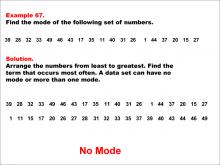
|
Math Example--Measures of Central Tendency--Mode: Example 67 | Math Example--Measures of Central Tendency--Mode: Example 67TopicMeasures of Central Tendency DescriptionThis example showcases a situation of measures of central tendency, where the goal is to identify a key summary measure in a set of data. Example 67 presents a list of numbers with no mode indicated. The numbers are sorted in ascending order. This example reinforces the concept that not all data sets have a mode, particularly when each number in the set appears only once. |
Data Analysis |
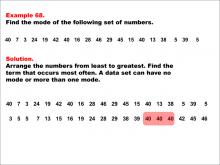
|
Math Example--Measures of Central Tendency--Mode: Example 68 | Math Example--Measures of Central Tendency--Mode: Example 68TopicMeasures of Central Tendency DescriptionThis example showcases a situation of measures of central tendency, where the goal is to identify a key summary measure in a set of data. Example 68 illustrates a set of numbers with the mode highlighted. The numbers are arranged in ascending order. This demonstrates how to identify the mode when a number appears more frequently than others in a data set. |
Data Analysis |
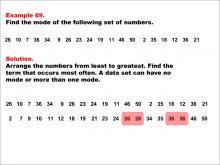
|
Math Example--Measures of Central Tendency--Mode: Example 69 | Math Example--Measures of Central Tendency--Mode: Example 69TopicMeasures of Central Tendency DescriptionThis example showcases a situation where there are multiple modes in a dataset. The image shows how numbers are arranged from least to greatest and highlights two modes: "26" and "36." This demonstrates that datasets can have more than one mode when two or more numbers appear with equal highest frequency. Lessons on measures of central tendency help students understand how to interpret data using different statistical measures like mean and median along with mode. |
Data Analysis |
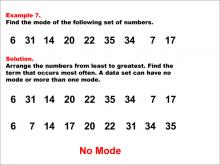
|
Math Example--Measures of Central Tendency--Mode: Example 7 | Math Example--Measures of Central Tendency--Mode: Example 7TopicMeasures of Central Tendency DescriptionThis example showcases a situation of measures of central tendency, where the goal is to identify a key summary measure in a set of data. Example 7 presents a set of numbers with no repeating values; no mode is found. This example reinforces the concept that not all data sets have a mode, particularly when each number in the set appears only once. |
Data Analysis |
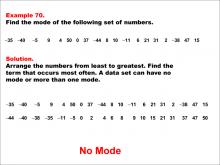
|
Math Example--Measures of Central Tendency--Mode: Example 70 | Math Example--Measures of Central Tendency--Mode: Example 70TopicMeasures of Central Tendency |
Data Analysis |

|
Math Example--Measures of Central Tendency--Mode: Example 71 | Math Example--Measures of Central Tendency--Mode: Example 71TopicMeasures of Central Tendency DescriptionThe image presents a math example on determining the mode of a sequence of numbers. After sorting them in order from least to greatest, the number -7 is highlighted as it appears most frequently. This demonstrates how to identify the mode when a number appears more frequently than others in a data set that includes both positive and negative numbers. Lessons on measures of central tendency help students understand how to interpret data using different statistical measures like mean and median along with mode. |
Data Analysis |
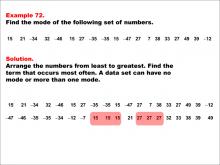
|
Math Example--Measures of Central Tendency--Mode: Example 72 | Math Example--Measures of Central Tendency--Mode: Example 72TopicMeasures of Central Tendency DescriptionThis image shows a math example on finding the mode in a data set. The numbers are sorted from least to greatest with two modes highlighted: 15 and 27. This demonstrates that a data set can have multiple modes, which occurs when two or more numbers appear with the highest frequency. Lessons on measures of central tendency help students understand how to interpret data using different statistical measures like mean and median along with mode. |
Data Analysis |
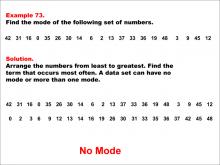
|
Math Example--Measures of Central Tendency--Mode: Example 73 | Math Example--Measures of Central Tendency--Mode: Example 73TopicMeasures of Central Tendency DescriptionThe image shows a math problem about finding the mode of a set of numbers. It includes the original set of numbers and the same set arranged in ascending order. The solution indicates "No Mode". This example reinforces the concept that not all data sets have a mode, particularly when each number in the set appears only once. Lessons on measures of central tendency help students understand how to interpret data using different statistical measures like mean and median along with mode. |
Data Analysis |
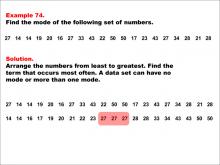
|
Math Example--Measures of Central Tendency--Mode: Example 74 | Math Example--Measures of Central Tendency--Mode: Example 74TopicMeasures of Central Tendency DescriptionThe image presents a math problem about finding the mode of a set of numbers. It shows the original set and the same set arranged in ascending order. The solution highlights the number 27 as occurring most frequently. This demonstrates how to identify the mode when a number appears more frequently than others in a data set. Lessons on measures of central tendency help students understand how to interpret data using different statistical measures like mean and median along with mode. |
Data Analysis |
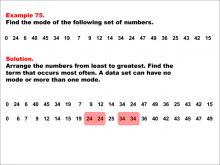
|
Math Example--Measures of Central Tendency--Mode: Example 75 | Math Example--Measures of Central Tendency--Mode: Example 75TopicMeasures of Central Tendency DescriptionThe image displays a math problem about finding the mode of a set of numbers. It includes the original set and the same set arranged in ascending order. The solution highlights two numbers, 24 and 34, as occurring most frequently. This demonstrates that a data set can have multiple modes, which occurs when two or more numbers appear with the highest frequency. Lessons on measures of central tendency help students understand how to interpret data using different statistical measures like mean and median along with mode. |
Data Analysis |

|
Math Example--Measures of Central Tendency--Mode: Example 76 | Math Example--Measures of Central Tendency--Mode: Example 76TopicMeasures of Central Tendency DescriptionThe image shows a math problem about finding the mode of a set of numbers. It presents the original set and the same set arranged in ascending order. The solution indicates "No Mode". This example reinforces the concept that not all data sets have a mode, particularly when each number in the set appears only once. Lessons on measures of central tendency help students understand how to interpret data using different statistical measures like mean and median along with mode. |
Data Analysis |
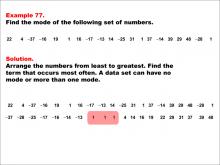
|
Math Example--Measures of Central Tendency--Mode: Example 77 | Math Example--Measures of Central Tendency--Mode: Example 77TopicMeasures of Central Tendency DescriptionThe image shows a math example focused on finding the mode of a set of numbers. The numbers are initially listed in random order and then rearranged from least to greatest. The mode is highlighted. This demonstrates how to identify the mode when a number appears more frequently than others in a data set that includes both positive and negative numbers. Lessons on measures of central tendency help students understand how to interpret data using different statistical measures like mean and median along with mode. |
Data Analysis |
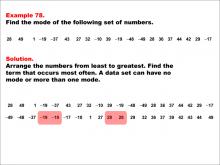
|
Math Example--Measures of Central Tendency--Mode: Example 78 | Math Example--Measures of Central Tendency--Mode: Example 78TopicMeasures of Central Tendency DescriptionThe image depicts another math example on finding the mode. It includes a list of numbers that are sorted from least to greatest. The mode is identified and highlighted in red. This demonstrates how to identify multiple modes when two or more numbers appear with equal highest frequency in a data set. Lessons on measures of central tendency help students understand how to interpret data using different statistical measures like mean and median along with mode. |
Data Analysis |

|
Math Example--Measures of Central Tendency--Mode: Example 8 | Math Example--Measures of Central Tendency--Mode: Example 8TopicMeasures of Central Tendency DescriptionThis example showcases a situation of measures of central tendency, where the goal is to identify a key summary measure in a set of data. Example 8 includes a set of numbers with one mode highlighted. The numbers are sorted in ascending order, revealing that 8 appears twice, while all other numbers appear only once. This demonstrates how to identify the mode when one number occurs more frequently than others in a data set. |
Data Analysis |
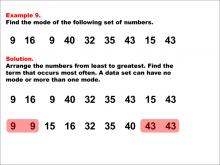
|
Math Example--Measures of Central Tendency--Mode: Example 9 | Math Example--Measures of Central Tendency--Mode: Example 9TopicMeasures of Central Tendency DescriptionThis example showcases a situation of measures of central tendency, where the goal is to identify a key summary measure in a set of data. The image shows an example of finding the mode from a set of numbers. The numbers are arranged from least to greatest, highlighting the most frequent ones. After sorting, it becomes clear that both 9 and 43 appear twice, while all other numbers appear only once. This example demonstrates that a data set can have more than one mode. |
Data Analysis |
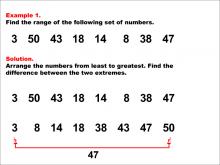
|
Math Example--Measures of Central Tendency--Range: Example 1 | Math Example--Measures of Central Tendency--Range: Example 1TopicMeasures of Central Tendency |
Data Analysis |
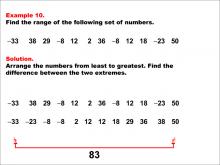
|
Math Example--Measures of Central Tendency--Range: Example 10 | Math Example--Measures of Central Tendency--Range: Example 10TopicMeasures of Central Tendency DescriptionThis example illustrates how to find the range of the following set of numbers: -33, 38, 29, -8, 12, 2, 36, -8, 12, 18, -23, 50. The solution involves arranging the numbers from least to greatest and finding the difference between the two extremes. The range is calculated to be 83. This example is particularly useful as it includes both positive and negative numbers, helping students understand how to handle different types of values when calculating the range. |
Data Analysis |
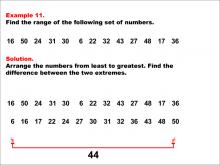
|
Math Example--Measures of Central Tendency--Range: Example 11 | Math Example--Measures of Central Tendency--Range: Example 11TopicMeasures of Central Tendency DescriptionThis example demonstrates how to find the range of the following set of numbers: 16, 50, 24, 31, 30, 6, 22, 32, 43, 27, 48, 17, 36. The solution involves arranging the numbers from least to greatest and finding the difference between the two extremes. The range is calculated to be 44. This example is valuable for understanding the concept of range, as it teaches students how to identify the maximum and minimum from a larger set of numbers and find their difference. |
Data Analysis |